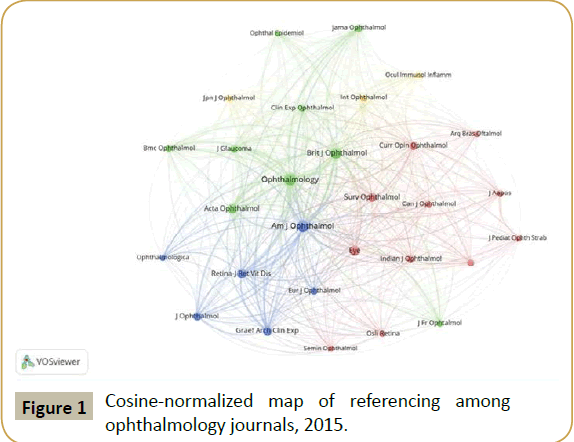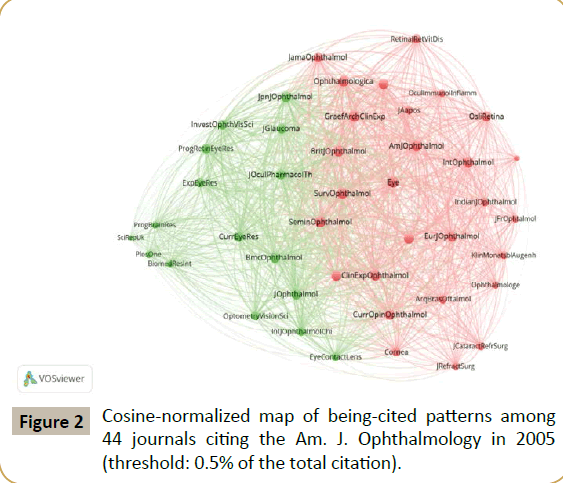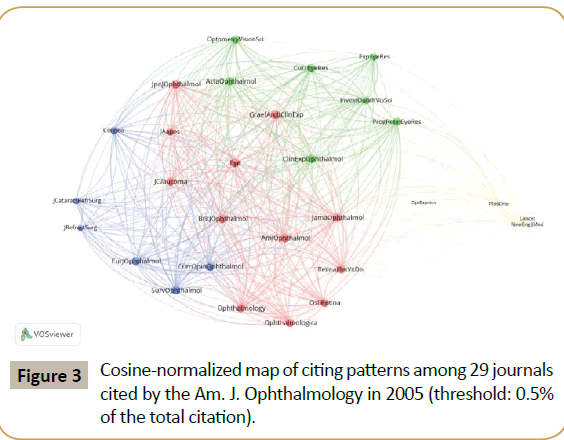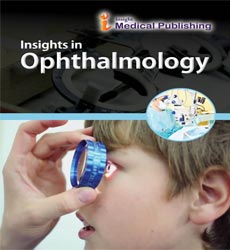Envisioning Vision: Journal Clusters in Ophthalmology
1Battelle Center for Science and Technology Policy, Glenn College of Public Affairs, The Ohio State University, Columbus, OH 43210, USA
2University of Amsterdam, Amsterdam School of Communication Research (ASCoR), P.O. Box-15793, 1001 NG Amsterdam, The Netherlands
- *Corresponding Author:
- Caroline S Wagner
Battelle Center for Science and Technology Policy
Glenn College of Public Affairs, The Ohio State University
Columbus, OH 43210, USA.
Tel: 614-206-8636
E-mail: wagner.911@osu.edu
Received date: November 09, 2016; Accepted date: December 16, 2016; Published date: December 24, 2016
Citation: Wagner CS, Leydesdorff L. Envisioning Vision: Journal Clusters in Ophthalmology. Ins Ophthal. 2017, 1:1.
Commentary
To bring disciplines such as ophthalmology into sharper focus, it is possible to visualize the connections among the refereed journals in this field. Using citations as representing connective tissue, one can delineate what are called epistemic communities or knowledge networks that constitute a discipline of science. The connections, when drawn as a network of links created by citations among journals, provide a visual, statistical, and cultural exploration of scholarly communication [1]. This brief perspective presents this analysis for ophthalmology.
For more than three centuries, refereed journals (exemplified in this analysis by Eye or Retina) have gathered together articles on scientific subjects. Perhaps Eye was founded in 1881 (under a different name) but articles about the eye were collected in other publications back to the start of the scientific revolution, as detailed in Hirshberg’s history [2]. Depending upon the field, the numbers of journals can grow rapidly, branching into specialties and subspecialties. Whether growing in number or diminishing, the practice of collecting sets of articles under the rubric of a journal title remains the recognized method of disseminating knowledge.
Journals are formed a new or created by merging other publications, as happened with the American Journal of Ophthalmology, which incorporated other publications and first appeared in its current form in 1918. Similarly, Eye earned its new name in 1987, but began publication in 1881 with the much longer name of Transactions of the Ophthalmological Societies of the United Kingdom. Some journals such as the British Journal of Ophthalmology cover basic science, while others, such as Survey of Ophthalmology, publish the results of clinical research. These differences in focus will influence the co-citation maps presented here and help determine clustering.
Historians of science [3] have suggested that subfields and new fields emerge when communications within a line of enquiry, and numbers of researchers, grow to a critical volume, at which point it splits off to self-identify as a constituency unto itself. This may have been the story of otolaryngology’s divergence from ophthalmology into a separate subfield from its nineteenth century days of sharing a professional association. A new branch of research may sprout because of a scientific discovery, technological change (such as the development of the ophthalmoscope), theoretical disagreements, trans-disciplinary cross-fertilization, or new problem spaces that compel innovative tactics. As new subfields emerge, articles will cite the “mother journals”, but often, these rebel upstarts will cross-cite to other fields or methodologies that represent new and distinct lines of thought, as is the case with the study of eye diseases among those with HIV/AIDS, where articles no doubt cite virology journals.
The process of envisioning a field’s epistemic community consists of identifying which journals cite other journals. Multiple approaches to such analyses have been debated over decades [4]; A recitation of the arguments would not advance this brief communication, only to say that it is widely accepted that applying statistical analyses to links among journals is considered a method of understanding the outlines and boundaries of a discipline [5]. The increasing importance of transdisciplinary journals such as PLoS ONE alongside multidisciplinary ones such as Nature and Science has not (yet) eroded the disciplinary structure of science; but functions as additional communication channels.
Social network analysis, in particular, is a happy convergence of graph theory and large-scale computing with algorithms that visualize critical connectivity. The graphs below represent networks derived from citing and cited behavior, with positions based upon distance among cited entities. The initial matrix is asymmetrical but a graph is derived by the visualization software, called VOSviewer [6]. The figure depicts the outlines of ophthalmology journals indexed in the Web of Science in 2015 as they provide references to one another.
The figure shows American Journal of Ophthalmology as the largest node in this network in 2015 (Figure 1). The size of the bubble reflects the attractiveness of the underlying journal in that year. In other words, the American Journal of Ophthalmology and Ophthalmology received more attention in the year studied than other journals. The curved lines emanating from the hubs to outer journals represent the citation relationships among them. The field is partly held together by the large hubs. Imagine that the two largest hubs in the figure are removed: one can see that the field might dissolve into less united subfields with relatively little connectivity among them.
The colors shown in the figure delineate cluster relationships among journals based upon numerical counts that are topically related to each other. The VOSviewer software determines these clusters. The figure shows only three significant subclusters. (The software can delineate up to 10 subclusters.) The meaning for the field of the three subclusters can be best determined by those well versed in the field.
The graphs suggest that ophthalmology is a highly integrated field clustered around a few hubs that have power over the development and direction of the field simply by virtue of their size and centrality. New ideas must traverse through the stronger hubs across the network to weaker hubs; ideas must be ‘recognized’ by the central hubs to pass across the field to other ‘clusters.’ This phenomenon of centrality retains the history of the field and conserves ideas. This retention process plays an important role in the epistemic culture of a field. Should disagreements arise that are not resolved in the ‘core,’ it is possible to imagine a new subfield breaking away (or being pulled away) by growing allegiance to another field (say, neuroscience) or, by dint of size, to grow into a discipline of its own, as ophthalmology once did from antecedent fields.
Figure 2:Cosine-normalized map of being-cited patterns among 44 journals citing the Am. J. Ophthalmology in 2005 (threshold: 0.5% of the total citation).
Figure 3:Cosine-normalized map of citing patterns among 29 journals cited by the Am. J. Ophthalmology in 2005 (threshold: 0.5% of the total citation).
Figures 2 and 3 present the citing and cited relationships for the hub created by the American Journal of Ophthalmology (AJoO) in 2005. In Figure 2, we see the journals in 2015 citing past publications. The figure is notable for being highly populated, dense, and uniform in intensity--with connections and interconnections crossing more than 40 journals. (The interconnections emanate from the journals citing AJoO while also citing other journals in the cluster.) This suggests that AJoO’s publications are widely read and broadly regarded, and that this journal serves as a knowledge trust for much of the ophthalmology field.
Figure 3 represents the journals cited by articles in AJoO in 2005. This figure is notable for being less populated and less dense. Articles in AJoO tend to cite other elite journals rather than recognizing work on the periphery of the field (Here we also see connections to the prestigious New England Journal of Medicine, and to the multidisciplinary journal, PLoS One.) This spacing may be indicating the knowledge retention role of the core journal, serving a conservative and more elite role relative to the field as a whole.
Should you wish to look deeper into this analysis, it is possible to visit the original graph for each journal at www.leydesdorff.net/ jcr15 and explore in more detail the connections among journals. Like the Fantastic Voyage in 1966, depicting a tiny spacecraft manoeuvering through the eyeball, the website allows one to traverse through the unseen world of journal connections to understand more about how to envision science.
References
- Price De-Solla DJ (1965) Networks of scientific papers. Science.
- Hirschberg J, Schett A, Mishima S (2002) The history of ophthalmology, Wayenborg.
- Price De-Solla DJ (1963) Big Science, Little Science. Columbia University Press, New York and London.
- Subelj L, Van Eck NJ, Waltman L (2016) Clustering scientific publications based on citation relations: A systematic comparison of different methods. PloS one 11: e0154404.
- Rafols I, Leydesdorff L (2009) Content-based and algorithmic classifications of journals: Perspectives on the dynamics of scientific communication and indexer effects. Journal of the American Society for Information Science and Technology 60: 1823-1835.
- Van Eck NJ, Waltman L (2010) Software survey: VOS viewer, A computer program for bibliometric mapping. Scientometrics 84: 523-538.
Open Access Journals
- Aquaculture & Veterinary Science
- Chemistry & Chemical Sciences
- Clinical Sciences
- Engineering
- General Science
- Genetics & Molecular Biology
- Health Care & Nursing
- Immunology & Microbiology
- Materials Science
- Mathematics & Physics
- Medical Sciences
- Neurology & Psychiatry
- Oncology & Cancer Science
- Pharmaceutical Sciences



